The Cambridge History of China. Vol. 12: Republican China, 1912-1949, Part 1
Подождите немного. Документ загружается.

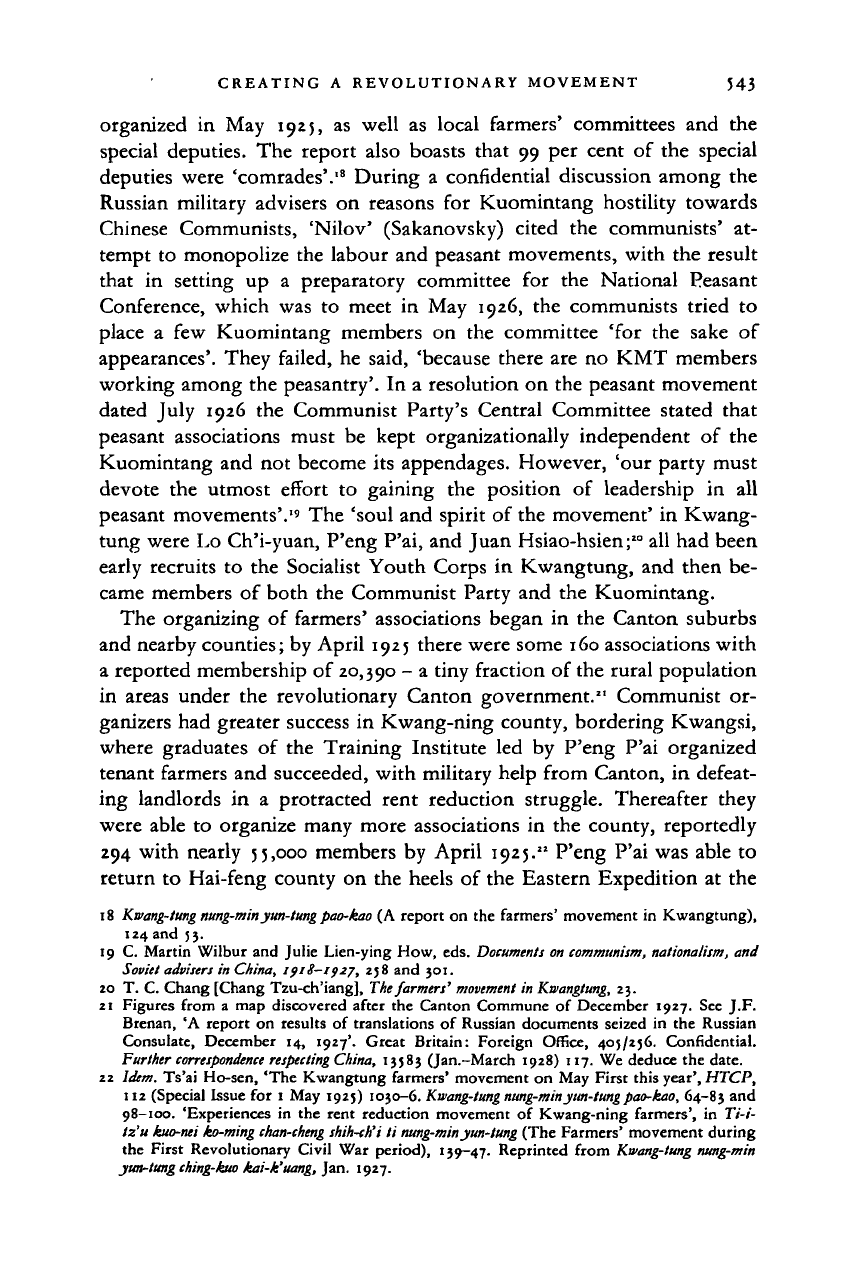
CREATING A REVOLUTIONARY MOVEMENT 543
organized in May 1925, as well as local farmers' committees and the
special deputies. The report also boasts that 99 per cent of the special
deputies were 'comrades'.
18
During a confidential discussion among the
Russian military advisers on reasons for Kuomintang hostility towards
Chinese Communists, 'Nilov' (Sakanovsky) cited the communists' at-
tempt to monopolize the labour and peasant movements, with the result
that in setting up a preparatory committee for the National Peasant
Conference, which was to meet in May 1926, the communists tried to
place a few Kuomintang members on the committee 'for the sake of
appearances'. They failed, he said, 'because there are no KMT members
working among the peasantry'. In a resolution on the peasant movement
dated July 1926 the Communist Party's Central Committee stated that
peasant associations must be kept organizationally independent of the
Kuomintang and not become its appendages. However, 'our party must
devote the utmost effort to gaining the position of leadership in all
peasant movements'.'
9
The 'soul and spirit of the movement' in Kwang-
tung were Lo Ch'i-yuan, P'eng P'ai, and Juan Hsiao-hsien;*° all had been
early recruits to the Socialist Youth Corps in Kwangtung, and then be-
came members of both the Communist Party and the Kuomintang.
The organizing of farmers' associations began in the Canton suburbs
and nearby counties; by April 1925 there were some 160 associations with
a reported membership of 20,390 - a tiny fraction of the rural population
in areas under the revolutionary Canton government.
21
Communist or-
ganizers had greater success in Kwang-ning county, bordering Kwangsi,
where graduates of the Training Institute led by P'eng P'ai organized
tenant farmers and succeeded, with military help from Canton, in defeat-
ing landlords in a protracted rent reduction struggle. Thereafter they
were able to organize many more associations in the county, reportedly
294 with nearly 55,000 members by April 1925." P'eng P'ai was able to
return to Hai-feng county on the heels of the Eastern Expedition at the
18
Kaang-tung nung-minyun-tung
pao-kao (A report on the farmers' movement in Kwangtung),
124 and 53.
19 C. Martin Wilbur and Julie Lien-ying How, eds.
Documents on
communism,
nationalism,
and
Soviet advisers
in
China,
191S-1927, 258 and 301.
20 T. C. Chang [Chang Tzu-ch'iang], The farmers'
movement
in
Kaangtung,
23.
21 Figures from a map discovered after the Canton Commune of December 1927. See J.F.
Brenan, 'A report on results of translations of Russian documents seized in the Russian
Consulate, December 14, 1927'. Great Britain: Foreign Office, 405/256. Confidential.
Further correspondence respecting
China,
13583 (Jan.-March 1928) 117. We deduce the date.
22 Idem. Ts'ai He-sen, "The Kwangtung farmers' movement on May First this year', HTCP,
112 (Special Issue for 1 May 1925) 1030-6.
Kwang-tung
nung-min
yun-tung
pao-kao, 64-83 and
98-100. 'Experiences in the rent reduction movement of Kwang-ning farmers', in 77-/-
tz'u
kuo-nei ko-ming chan-cheng shih-th'i
ti nung-min yun-tung (The Farmers' movement during
the First Revolutionary Civil War period), 139-47. Reprinted from Kaang-tung
nung-min
yun-tung ching-kuo
kai-k'uang, Jan. 1927.
Cambridge Histories Online © Cambridge University Press, 2008
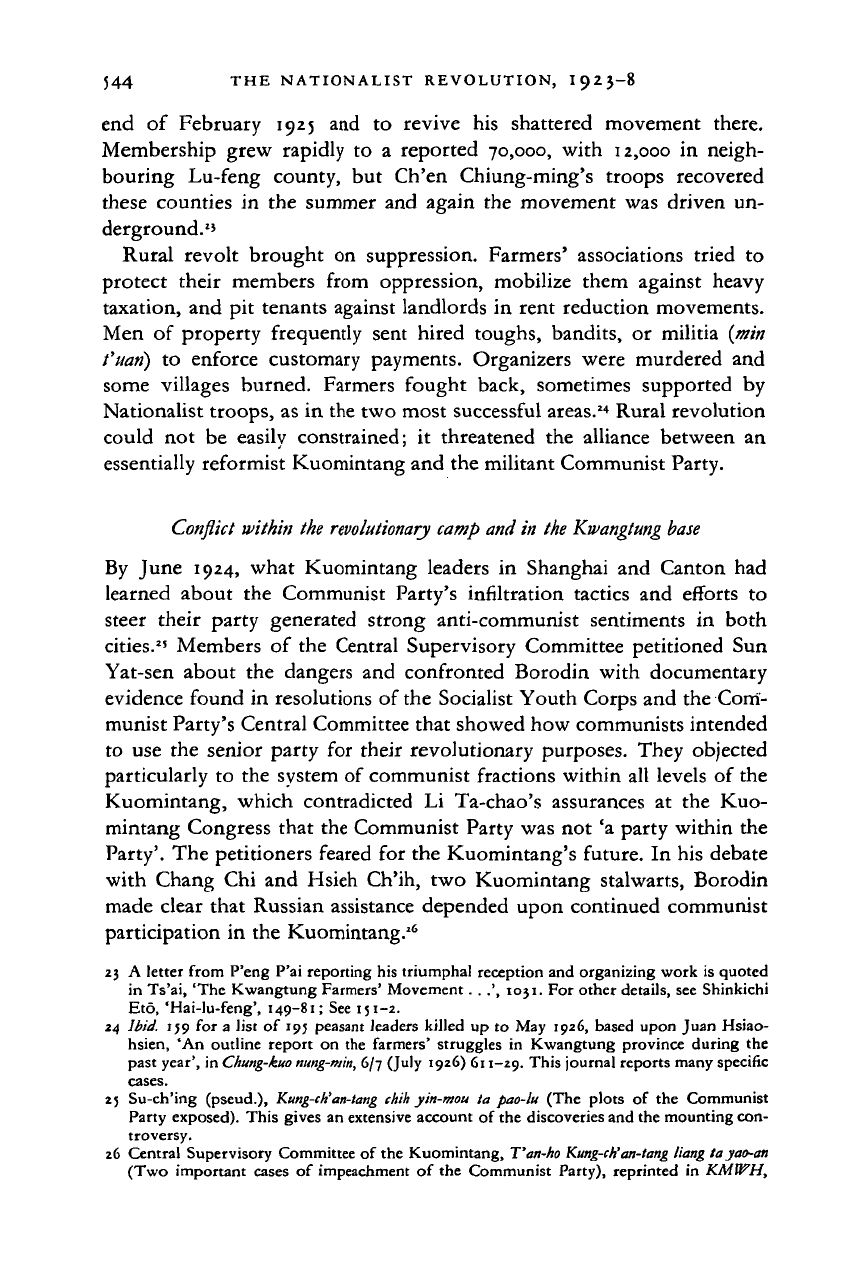
544 THE NATIONALIST REVOLUTION, I 9
2
3-8
end
of
February 1925
and to
revive
his
shattered movement there.
Membership grew rapidly
to a
reported 70,000, with 12,000
in
neigh-
bouring Lu-feng county,
but
Ch'en Chiung-ming's troops recovered
these counties
in
the summer and again the movement was driven un-
derground.
25
Rural revolt brought
on
suppression. Farmers' associations tried
to
protect their members from oppression, mobilize them against heavy
taxation, and pit tenants against landlords
in
rent reduction movements.
Men
of
property frequently sent hired toughs, bandits,
or
militia {min
fuari)
to
enforce customary payments. Organizers were murdered and
some villages burned. Farmers fought back, sometimes supported
by
Nationalist troops, as in the two most successful areas.
24
Rural revolution
could
not be
easily constrained;
it
threatened
the
alliance between
an
essentially reformist Kuomintang and the militant Communist Party.
Conflict within the
revolutionary
camp and in the Kwangtung
base
By June 1924, what Kuomintang leaders
in
Shanghai and Canton had
learned about
the
Communist Party's infiltration tactics and efforts
to
steer their party generated strong anti-communist sentiments
in
both
cities.
2
'
Members
of
the Central Supervisory Committee petitioned Sun
Yat-sen about
the
dangers and confronted Borodin with documentary
evidence found in resolutions of the Socialist Youth Corps and the Com-
munist Party's Central Committee that showed how communists intended
to use the senior party
for
their revolutionary purposes. They objected
particularly
to
the system of communist fractions within all levels
of
the
Kuomintang, which contradicted
Li
Ta-chao's assurances
at the
Kuo-
mintang Congress that the Communist Party was not
'a
party within the
Party'. The petitioners feared for the Kuomintang's future. In his debate
with Chang Chi and Hsieh Ch'ih, two Kuomintang stalwarts, Borodin
made clear that Russian assistance depended upon continued communist
participation in the Kuomintang.
26
23
A
letter from P'eng P'ai reporting his triumphal reception and organizing work
is
quoted
in Ts'ai, 'The Kwangtung Farmers' Movement.
. .',
1031. For other details, see Shinkichi
Eto,
'Hai-lu-feng',
149-81;
See 151-2.
24
Ibid.
159
for a
list
of
195 peasant leaders killed up
to
May 1926, based upon Juan Hsiao-
hsien,
'An
outline report
on
the farmers' struggles
in
Kwangtung province during
the
past year', in Chung-kuo
nung-min,
6/7 (July 1926) 611-29. This journal reports many specific
cases.
25 Su-ch'ing (pseud.),
Kung-ch'an-tang chih
yin-mou
ta
pao-lu (The plots
of the
Communist
Party exposed). This gives an extensive account
of
the discoveries and the mounting con-
troversy.
26 Central Supervisory Committee
of
the Kuomintang,
T'an-ko
Kung-ch'an-tang Hang
tayao-an
(Two important cases
of
impeachment
of
the Communist Party), reprinted
in
KMWH,
Cambridge Histories Online © Cambridge University Press, 2008
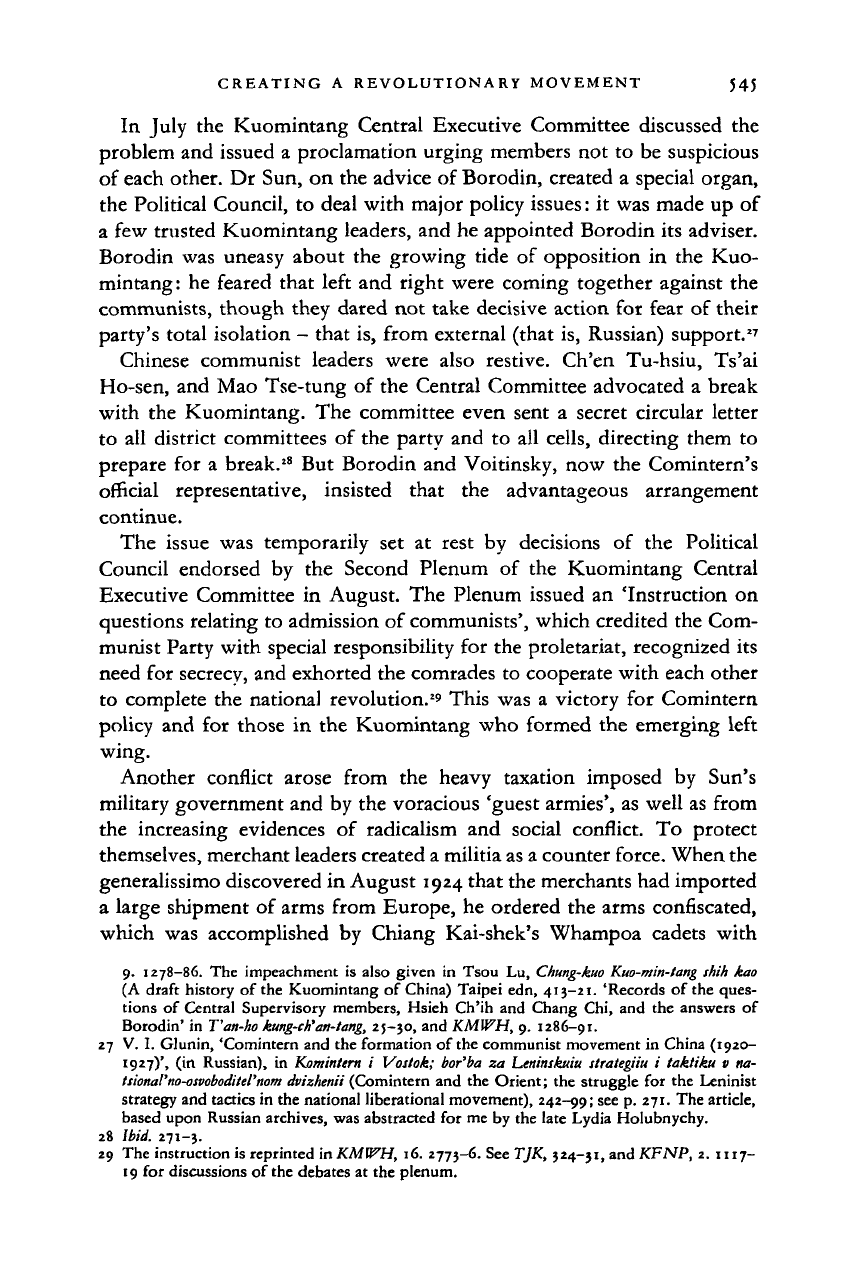
CREATING
A
REVOLUTIONARY MOVEMENT
545
In. July
the
Kuomintang Central Executive Committee discussed
the
problem
and
issued
a
proclamation urging members
not to be
suspicious
of each other.
Dr Sun, on the
advice
of
Borodin, created
a
special organ,
the Political Council,
to
deal with major policy issues:
it was
made
up of
a
few
trusted Kuomintang leaders,
and he
appointed Borodin
its
adviser.
Borodin
was
uneasy about
the
growing tide
of
opposition
in the Kuo-
mintang
:
he
feared that left
and
right were coming together against
the
communists, though they dared
not
take decisive action
for
fear
of
their
party's total isolation
-
that
is,
from external (that
is,
Russian) support.
27
Chinese communist leaders were also restive. Ch'en Tu-hsiu, Ts'ai
Ho-sen,
and Mao
Tse-tung
of the
Central Committee advocated
a
break
with
the
Kuomintang.
The
committee even sent
a
secret circular letter
to
all
district committees
of the
party
and to all
cells, directing them
to
prepare
for a
break.
28
But
Borodin
and
Voitinsky,
now the
Comintern's
official representative, insisted that
the
advantageous arrangement
continue.
The issue
was
temporarily
set at
rest
by
decisions
of the
Political
Council endorsed
by the
Second Plenum
of the
Kuomintang Central
Executive Committee
in
August.
The
Plenum issued
an
'Instruction
on
questions relating
to
admission
of
communists', which credited
the Com-
munist Party with special responsibility
for the
proletariat, recognized
its
need
for
secrecy,
and
exhorted
the
comrades
to
cooperate with each other
to complete
the
national revolution.
29
This
was a
victory
for
Comintern
policy
and for
those
in the
Kuomintang
who
formed
the
emerging left
wing.
Another conflict arose from
the
heavy taxation imposed
by
Sun's
military government
and by the
voracious 'guest armies',
as
well
as
from
the increasing evidences
of
radicalism
and
social conflict.
To
protect
themselves, merchant leaders created a militia as
a
counter force. When
the
generalissimo discovered
in
August 1924 that
the
merchants
had
imported
a large shipment
of
arms from Europe,
he
ordered
the
arms confiscated,
which
was
accomplished
by
Chiang Kai-shek's Whampoa cadets with
9. 1278-86. The impeachment is also given in Tsou Lu,
Chung-kuo Kuo-min-tang shih
kao
(A draft history of the Kuomintang of China) Taipei edn,
413-21.
'Records of the ques-
tions of Central Supervisory members, Hsieh Ch'ih and Chang Chi, and the answers of
Borodin' in
T'an-ho
kung-cti'art-tang,
25-30, and
KMWH,
9.
1286-91.
27 V. I. Glunin, 'Comintern and the formation of the communist movement in China (1920-
1927)',
(in Russian), in
Komintern
i
l^ostok;
bor'ba za
Leni>uikuiu strategiiu
i taktiku v na-
tsional'no-osvoboditeVnom dvizhenii
(Comintern and the Orient; the struggle for the Leninist
strategy and tactics in the national liberational movement), 242-99; see p. 271. The article,
based upon Russian archives, was abstracted for me by the late Lydia Holubnychy.
28
Ibid.
271-3.
29 The instruction is reprinted in
KMWH,
16. 2773-6. See TJK,
324-31,
and KFNP, 2. 1117-
19 for discussions of the debates at the plenum.
Cambridge Histories Online © Cambridge University Press, 2008
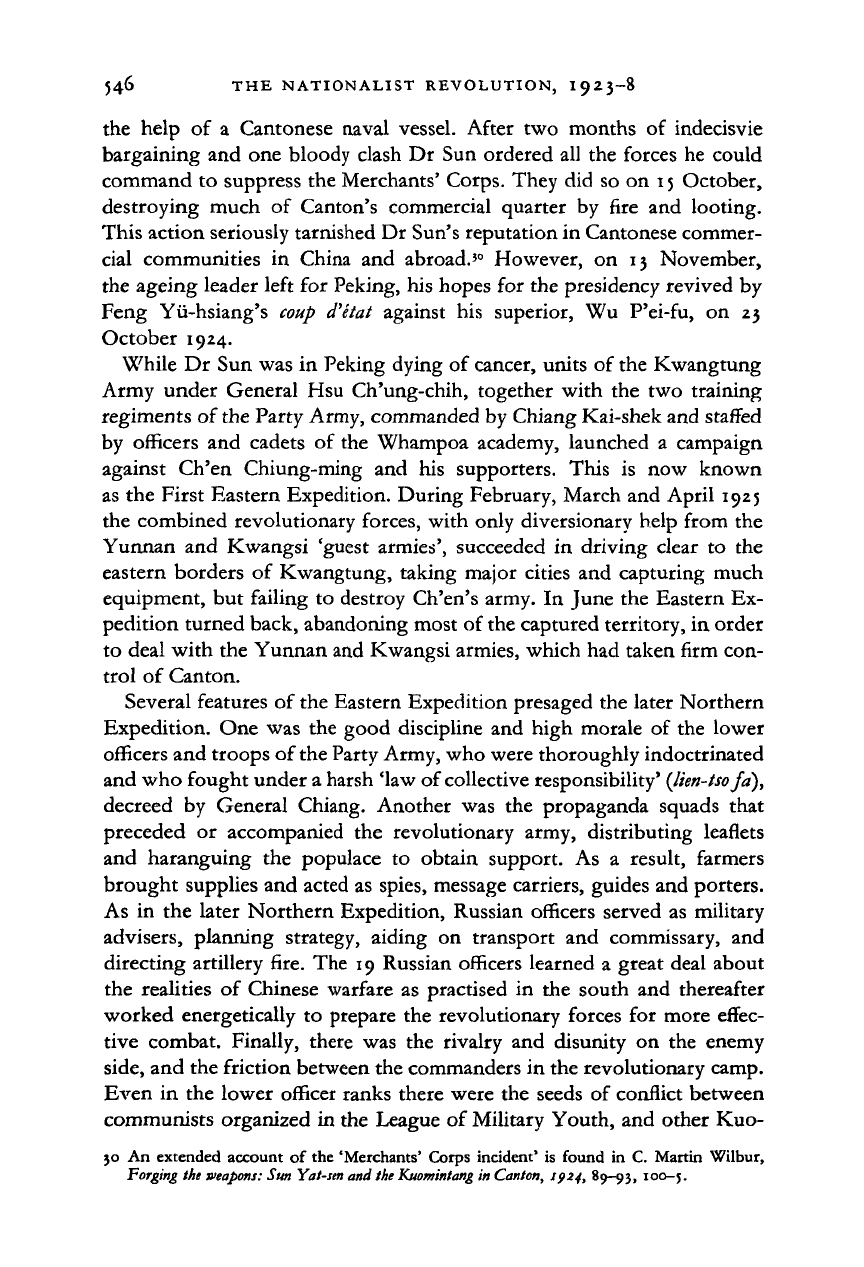
546 THE NATIONALIST REVOLUTION, I923-8
the help
of a
Cantonese naval vessel. After
two
months
of
indecisvie
bargaining
and one
bloody clash
Dr Sun
ordered
all the
forces
he
could
command
to
suppress the Merchants' Corps. They
did so on
15 October,
destroying much
of
Canton's commercial quarter
by
fire
and
looting.
This action seriously tarnished Dr Sun's reputation in Cantonese commer-
cial communities
in
China
and
abroad.
50
However,
on 13
November,
the ageing leader left
for
Peking, his hopes
for
the presidency revived
by
Feng Yii-hsiang's coup d'etat against
his
superior,
Wu
P'ei-fu,
on 23
October 1924.
While
Dr
Sun was
in
Peking dying
of
cancer, units
of
the Kwangtung
Army under General
Hsu
Ch'ung-chih, together with
the two
training
regiments
of
the Party Army, commanded by Chiang Kai-shek and staffed
by officers
and
cadets
of
the Whampoa academy, launched
a
campaign
against Ch'en Chiung-ming
and his
supporters. This
is now
known
as
the
First Eastern Expedition. During February, March
and
April 1925
the combined revolutionary forces, with only diversionary help from
the
Yunnan
and
Kwangsi 'guest armies', succeeded
in
driving clear
to the
eastern borders
of
Kwangtung, taking major cities
and
capturing much
equipment,
but
failing
to
destroy Ch'en's army.
In
June
the
Eastern
Ex-
pedition turned back, abandoning most
of
the captured territory,
in
order
to deal with
the
Yunnan and Kwangsi armies, which
had
taken firm
con-
trol
of
Canton.
Several features
of
the Eastern Expedition presaged
the
later Northern
Expedition.
One was the
good discipline
and
high morale
of the
lower
officers and troops
of
the Party Army, who were thoroughly indoctrinated
and who fought under a harsh 'law
of
collective responsibility' (lien-tso
fa),
decreed
by
General Chiang. Another
was the
propaganda squads that
preceded
or
accompanied
the
revolutionary army, distributing leaflets
and haranguing
the
populace
to
obtain support.
As a
result, farmers
brought supplies
and
acted
as
spies, message carriers, guides and porters.
As
in the
later Northern Expedition, Russian officers served
as
military
advisers, planning strategy, aiding
on
transport
and
commissary,
and
directing artillery fire.
The 19
Russian officers learned
a
great deal about
the realities
of
Chinese warfare
as
practised
in the
south
and
thereafter
worked energetically
to
prepare
the
revolutionary forces
for
more effec-
tive combat. Finally, there
was the
rivalry
and
disunity
on the
enemy
side,
and
the friction between the commanders
in
the revolutionary camp.
Even
in the
lower officer ranks there were
the
seeds
of
conflict between
communists organized
in
the League
of
Military Youth,
and
other Kuo-
)o
An
extended account
of the
'Merchants' Corps incident"
is
found
in C.
Martin Wilbur,
Forging
the
weapons:
Sun Yat-sen
and
the Kuomintang
in
Canton,
1924, 89-93,
100-j.
Cambridge Histories Online © Cambridge University Press, 2008
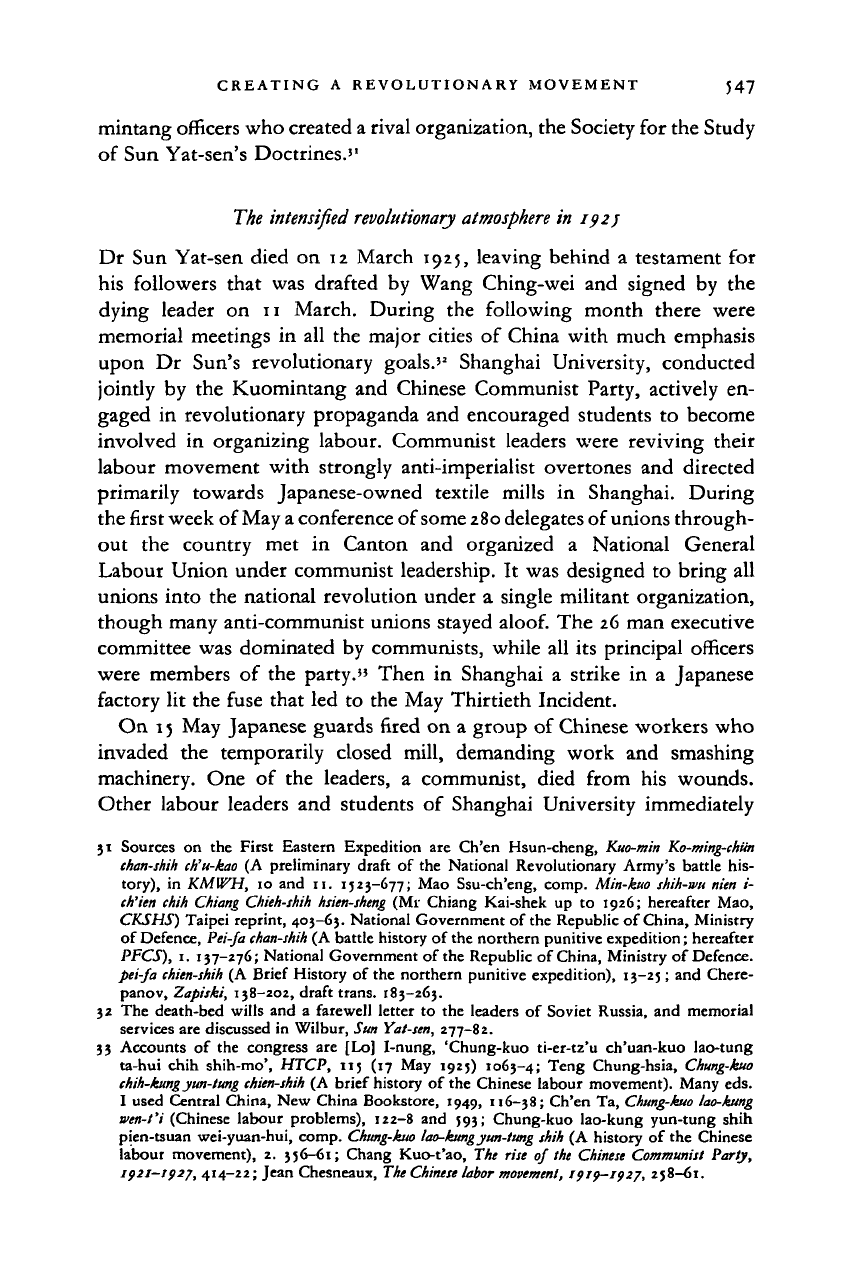
CREATING A REVOLUTIONARY MOVEMENT 547
mintang officers who created a rival organization, the Society for the Study
of Sun Yat-sen's Doctrines.'
1
The
intensified revolutionary atmosphere
in 192J
Dr Sun Yat-sen died on 12 March 1925, leaving behind a testament for
his followers that was drafted by Wang Ching-wei and signed by the
dying leader on 11 March. During the following month there were
memorial meetings in all the major cities of China with much emphasis
upon Dr Sun's revolutionary goals.'
2
Shanghai University, conducted
jointly by the Kuomintang and Chinese Communist Party, actively en-
gaged in revolutionary propaganda and encouraged students to become
involved in organizing labour. Communist leaders were reviving their
labour movement with strongly anti-imperialist overtones and directed
primarily towards Japanese-owned textile mills in Shanghai. During
the first week of May a conference of some
280
delegates of unions through-
out the country met in Canton and organized a National General
Labour Union under communist leadership. It was designed to bring all
unions into the national revolution under a single militant organization,
though many anti-communist unions stayed
aloof.
The 26 man executive
committee was dominated by communists, while all its principal officers
were members of the party." Then in Shanghai a strike in a Japanese
factory lit the fuse that led to the May Thirtieth Incident.
On 15 May Japanese guards fired on a group of Chinese workers who
invaded the temporarily closed mill, demanding work and smashing
machinery. One of the leaders, a communist, died from his wounds.
Other labour leaders and students of Shanghai University immediately
31 Sources on the First Eastern Expedition are Ch'en Hsun-cheng, Kuo-min
Ko-ming-chim
chan-shih ch'u-kao
(A preliminary draft of the National Revolutionary Army's battle his-
tory),
in
KMWH,
10 and n. 1523-677; Mao Ssu-ch'eng, comp. Min-kito
shih-wu nien
i-
ch'icn
chih Chiang
Chieh-shih hsien-sheng
(Mr Chiang Kai-shek up to 1926; hereafter Mao,
CKSHS) Taipei reprint, 403-63. National Government of the Republic of China, Ministry
of Defence, Pei-fa
chan-shih
(A battle history of the northern punitive expedition; hereafter
PFCS),
1. 137-276; National Government of the Republic of China, Ministry of Defence.
pei-fa
chien-shih
(A Brief History of the northern punitive expedition), 13-25; and Chere-
panov, Zapiski, 138-202, draft trans. 183-263.
32 The death-bed wills and a farewell letter to the leaders of Soviet Russia, and memorial
services are discussed in Wilbur, Sun Yat-sen, 277-82.
33 Accounts of the congress are [Lo] I-nung, 'Chung-kuo ti-er-tz'u ch'uan-kuo lao-tung
ta-hui chih shih-mo', HTCP, 115 (17 May 1925) 1063-4; Teng Chung-hsia,
Chung-kuo
chih-kung yun-tung
chien-shih
(A brief history of the Chinese labour movement). Many eds.
I used Central China, New China Bookstore, 1949, 116-38; Ch'en Ta,
Chung-kuo lao-kung
wen-t'i (Chinese labour problems), 122-8 and 593; Chung-kuo lao-kung yun-tung shih
pien-tsuan wei-yuan-hui, comp.
Chung-kuo
lao-kung yun-tung
shih
(A history of the Chinese
labour movement), 2. 356-61; Chang Kuo-t'ao, The rise of
the Chinese
Communist Party,
1021-192J, 414-22; Jean Chesneaux,
The Chinese
labor
movement,
rprp-102/, 258-61.
Cambridge Histories Online © Cambridge University Press, 2008
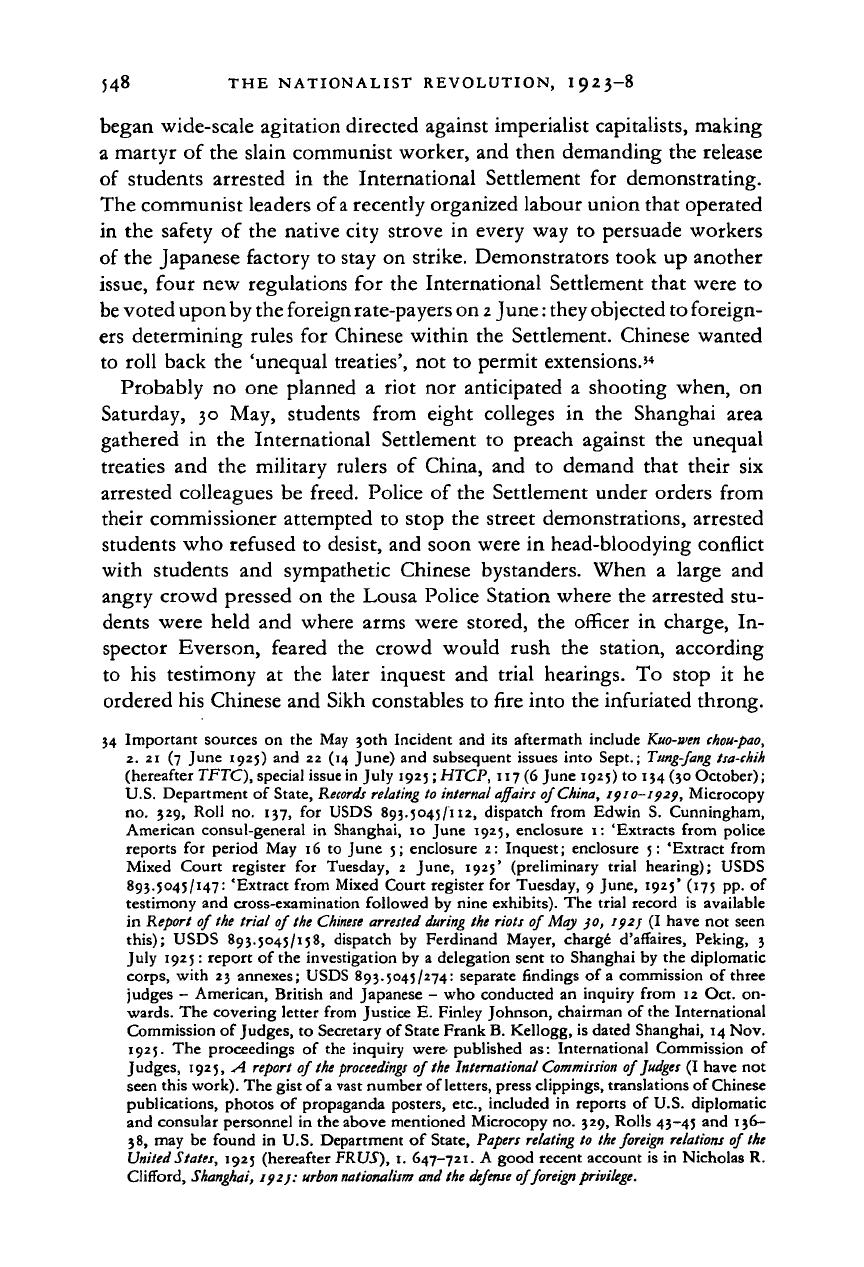
548 THE NATIONALIST REVOLUTION, I 9
2
3-8
began wide-scale agitation directed against imperialist capitalists, making
a martyr
of
the slain communist worker,
and
then demanding
the
release
of students arrested
in the
International Settlement
for
demonstrating.
The communist leaders of a recently organized labour union that operated
in
the
safety
of the
native city strove
in
every
way to
persuade workers
of the Japanese factory
to
stay
on
strike. Demonstrators took
up
another
issue, four
new
regulations
for the
International Settlement that were
to
be
voted upon by the foreign rate-payers on
2
June: they objected to foreign-
ers determining rules
for
Chinese within
the
Settlement. Chinese wanted
to roll back
the
'unequal treaties',
not to
permit extensions.'
4
Probably
no one
planned
a
riot
nor
anticipated
a
shooting when,
on
Saturday,
30 May,
students from eight colleges
in the
Shanghai area
gathered
in the
International Settlement
to
preach against
the
unequal
treaties
and the
military rulers
of
China,
and to
demand that their
six
arrested colleagues
be
freed. Police
of
the Settlement under orders from
their commissioner attempted
to
stop
the
street demonstrations, arrested
students
who
refused
to
desist,
and
soon were
in
head-bloodying conflict
with students
and
sympathetic Chinese bystanders. When
a
large
and
angry crowd pressed
on the
Lousa Police Station where
the
arrested
stu-
dents were held
and
where arms were stored,
the
officer
in
charge,
In-
spector Everson, feared
the
crowd would rush
the
station, according
to
his
testimony
at the
later inquest
and
trial hearings.
To
stop
it he
ordered his Chinese
and
Sikh constables
to
fire into
the
infuriated throng.
34 Important sources
on the May
30th Incident
and its
aftermath include
Kuo-a>en
chou-pao,
2.
21 (7
June 1925)
and 22 (14
June)
and
subsequent issues into Sept.;
Tung-fang tsa-chih
(hereafter TFTC), special issue in July
1925;
HTCP, 117(6 June 1925)
to
134 (30 October);
U.S.
Department
of
State,
Records relating
to
internal affairs
of
China,
1910-1929,
Microcopy
no.
329,
Roll
no. 137, for
USDS 893.5045/112, dispatch from Edwin
S.
Cunningham,
American consul-general
in
Shanghai,
10
June 1925, enclosure
1:
'Extracts from police
reports
for
period
May 16 to
June
5;
enclosure
2:
Inquest; enclosure
5:
'Extract from
Mixed Court register
for
Tuesday,
2
June,
1925'
(preliminary trial hearing); USDS
893.5045/147: 'Extract from Mixed Court register
for
Tuesday,
9
June, 1925' (175 pp.
of
testimony
and
cross-examination followed
by
nine exhibits).
The
trial record
is
available
in
Report
of
the
trial of
the Chinese arrested during the riots
of
May
}0,
192;
(I
have
not
seen
this);
USDS 893.5045/158, dispatch
by
Ferdinand Mayer, charg£ d'affaires, Peking,
3
July 1925: report
of
the investigation
by a
delegation sent
to
Shanghai
by the
diplomatic
corps,
with
23
annexes; USDS 893.5045/274: separate findings
of
a commission
of
three
judges
—
American, British
and
Japanese
- who
conducted
an
inquiry from
12 Oct. on-
wards. The covering letter from Justice
E.
Finley Johnson, chairman
of
the International
Commission
of
Judges,
to
Secretary
of
State Frank
B.
Kellogg, is dated Shanghai, 14 Nov.
1925.
The
proceedings
of the
inquiry were published
as:
International Commission
of
Judges, 1925,
^4
report
of
the proceedings
of
the International Commission
of
Judges
(I
have
not
seen this work). The gist of a vast number of letters, press clippings, translations of Chinese
publications, photos
of
propaganda posters, etc., included
in
reports
of
U.S. diplomatic
and consular personnel
in
the above mentioned Microcopy no. 329, Rolls 43-45
and
136-
38,
may be
found
in
U.S. Department
of
State,
Papers relating
to the
foreign relations
of
the
United
States,
1925 (hereafter FRUS), 1.
647-721.
A
good recent account
is in
Nicholas
R.
Clifford,
Shanghai,
192/:
urbon nationalism and the defense
of
foreign
privilege.
Cambridge Histories Online © Cambridge University Press, 2008
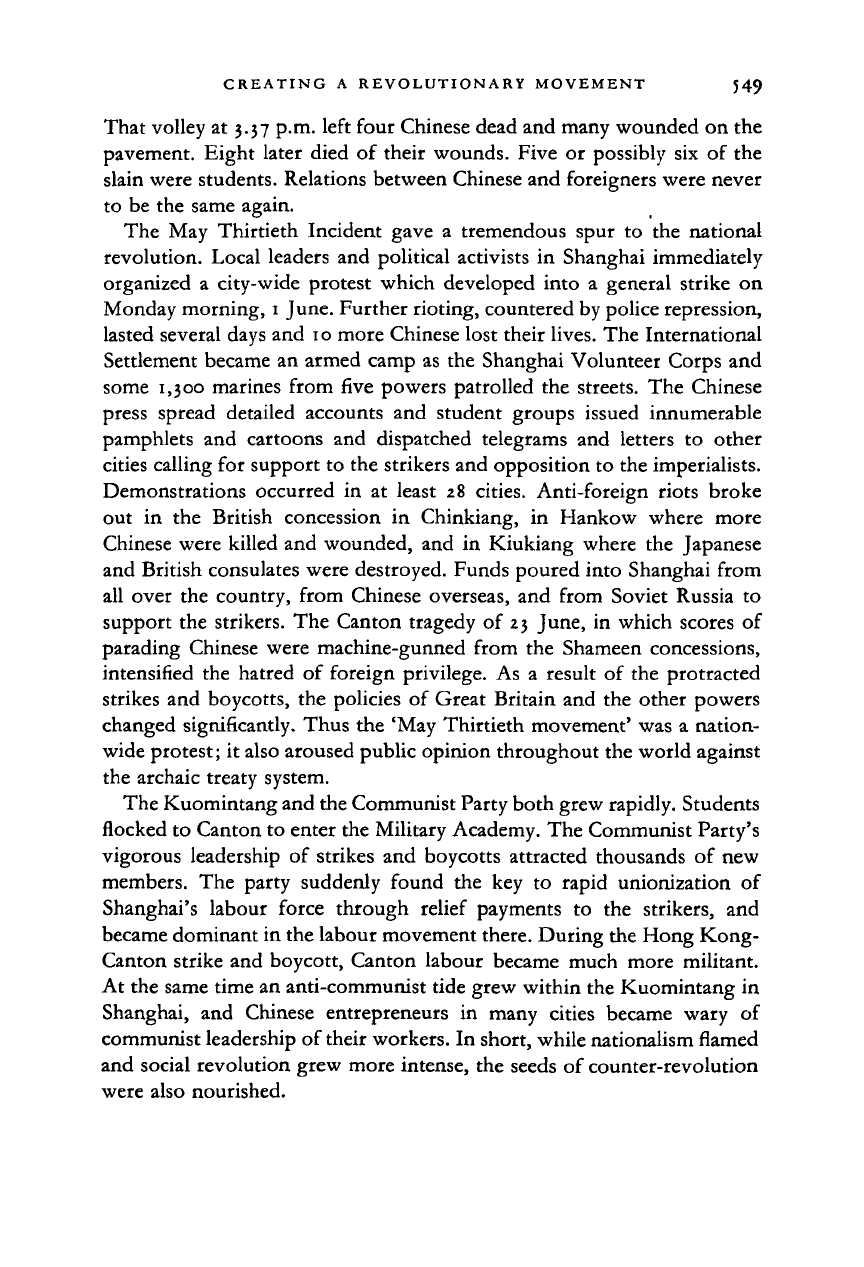
CREATING A REVOLUTIONARY MOVEMENT 549
That volley at 3.37 p.m. left four Chinese dead and many wounded on the
pavement. Eight later died of their wounds. Five or possibly six of the
slain were students. Relations between Chinese and foreigners were never
to be the same again.
The May Thirtieth Incident gave a tremendous spur to the national
revolution. Local leaders and political activists in Shanghai immediately
organized a city-wide protest which developed into a general strike on
Monday morning,
1
June. Further rioting, countered by police repression,
lasted several days and 10 more Chinese lost their lives. The International
Settlement became an armed camp as the Shanghai Volunteer Corps and
some 1,300 marines from five powers patrolled the streets. The Chinese
press spread detailed accounts and student groups issued innumerable
pamphlets and cartoons and dispatched telegrams and letters to other
cities calling for support to the strikers and opposition to the imperialists.
Demonstrations occurred in at least 28 cities. Anti-foreign riots broke
out in the British concession in Chinkiang, in Hankow where more
Chinese were killed and wounded, and in Kiukiang where the Japanese
and British consulates were destroyed. Funds poured into Shanghai from
all over the country, from Chinese overseas, and from Soviet Russia to
support the strikers. The Canton tragedy of 23 June, in which scores of
parading Chinese were machine-gunned from the Shameen concessions,
intensified the hatred of foreign privilege. As a result of the protracted
strikes and boycotts, the policies of Great Britain and the other powers
changed significantly. Thus the 'May Thirtieth movement' was a nation-
wide protest; it also aroused public opinion throughout the world against
the archaic treaty system.
The Kuomintang and the Communist Party both grew rapidly. Students
flocked to Canton to enter the Military Academy. The Communist Party's
vigorous leadership of strikes and boycotts attracted thousands of new
members. The party suddenly found the key to rapid unionization of
Shanghai's labour force through relief payments to the strikers, and
became dominant in the labour movement there. During the Hong Kong-
Canton strike and boycott, Canton labour became much more militant.
At the same time an anti-communist tide grew within the Kuomintang in
Shanghai, and Chinese entrepreneurs in many cities became wary of
communist leadership of their workers. In short, while nationalism flamed
and social revolution grew more intense, the seeds of counter-revolution
were also nourished.
Cambridge Histories Online © Cambridge University Press, 2008
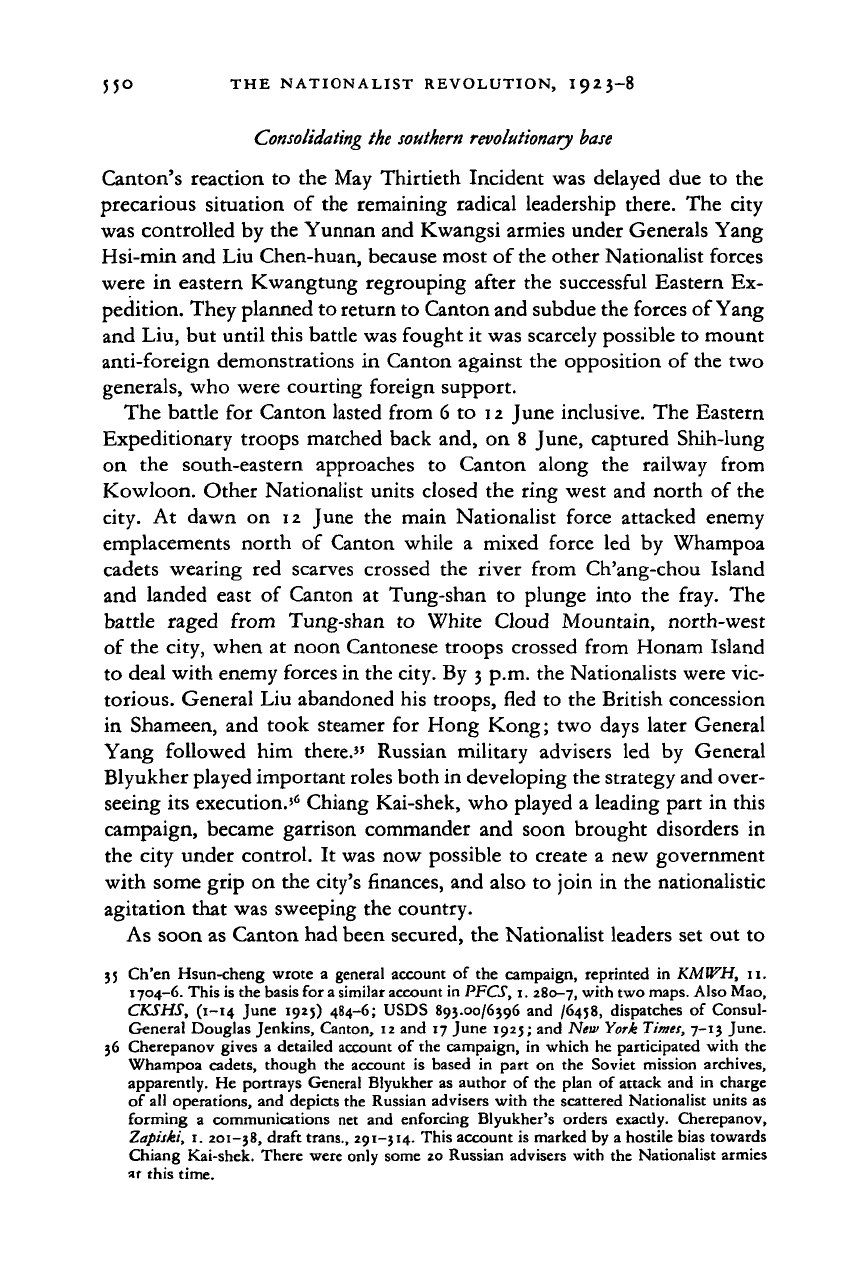
550 THE NATIONALIST REVOLUTION, 1923-8
Consolidating the southern revolutionary base
Canton's reaction to the May Thirtieth Incident was delayed due to the
precarious situation of the remaining radical leadership there. The city
was controlled by the Yunnan and Kwangsi armies under Generals Yang
Hsi-min and Liu Chen-huan, because most of the other Nationalist forces
were in eastern Kwangtung regrouping after the successful Eastern Ex-
pedition. They planned to return to Canton and subdue the forces of Yang
and Liu, but until this battle was fought it was scarcely possible to mount
anti-foreign demonstrations in Canton against the opposition of the two
generals, who were courting foreign support.
The battle for Canton lasted from 6 to
i
z June inclusive. The Eastern
Expeditionary troops marched back and, on 8 June, captured Shih-lung
on the south-eastern approaches to Canton along the railway from
Kowloon. Other Nationalist units closed the ring west and north of the
city. At dawn on 12 June the main Nationalist force attacked enemy
emplacements north of Canton while a mixed force led by Whampoa
cadets wearing red scarves crossed the river from Ch'ang-chou Island
and landed east of Canton at Tung-shan to plunge into the fray. The
battle raged from Tung-shan to White Cloud Mountain, north-west
of the city, when at noon Cantonese troops crossed from Honam Island
to deal with enemy forces in the city. By
3
p.m. the Nationalists were vic-
torious. General Liu abandoned his troops, fled to the British concession
in Shameen, and took steamer for Hong Kong; two days later General
Yang followed him there." Russian military advisers led by General
Blyukher played important roles both in developing the strategy and over-
seeing its execution.
5
' Chiang Kai-shek, who played a leading part in this
campaign, became garrison commander and soon brought disorders in
the city under control. It was now possible to create a new government
with some grip on the city's finances, and also to join in the nationalistic
agitation that was sweeping the country.
As soon as Canton had been secured, the Nationalist leaders set out to
35 Ch'en Hsun-cheng wrote a general account of the campaign, reprinted in
KMWH,
11.
1704-6. This is the basis for a similar account in PFCS, 1. 280-7, with two maps. Also Mao,
CKSHS, (1-14 June 1925) 484-6; USDS 893.00/6396 and /(>458, dispatches of Consul-
General Douglas Jenkins, Canton, 12 and 17 June 1925; and New York Times, 7-13 June.
36 Cherepanov gives a detailed account of the campaign, in which he participated with the
Whampoa cadets, though the account is based in part on the Soviet mission archives,
apparently. He portrays General Blyukher as author of the plan of attack and in charge
of all operations, and depicts the Russian advisers with the scattered Nationalist units as
forming a communications net and enforcing Blyukher's orders exactly. Cherepanov,
Zapiski, 1. 201-38, draft trans., 291-314. This account is marked by a hostile bias towards
Chiang Kai-shek. There were only some 20 Russian advisers with the Nationalist armies
ar this time.
Cambridge Histories Online © Cambridge University Press, 2008
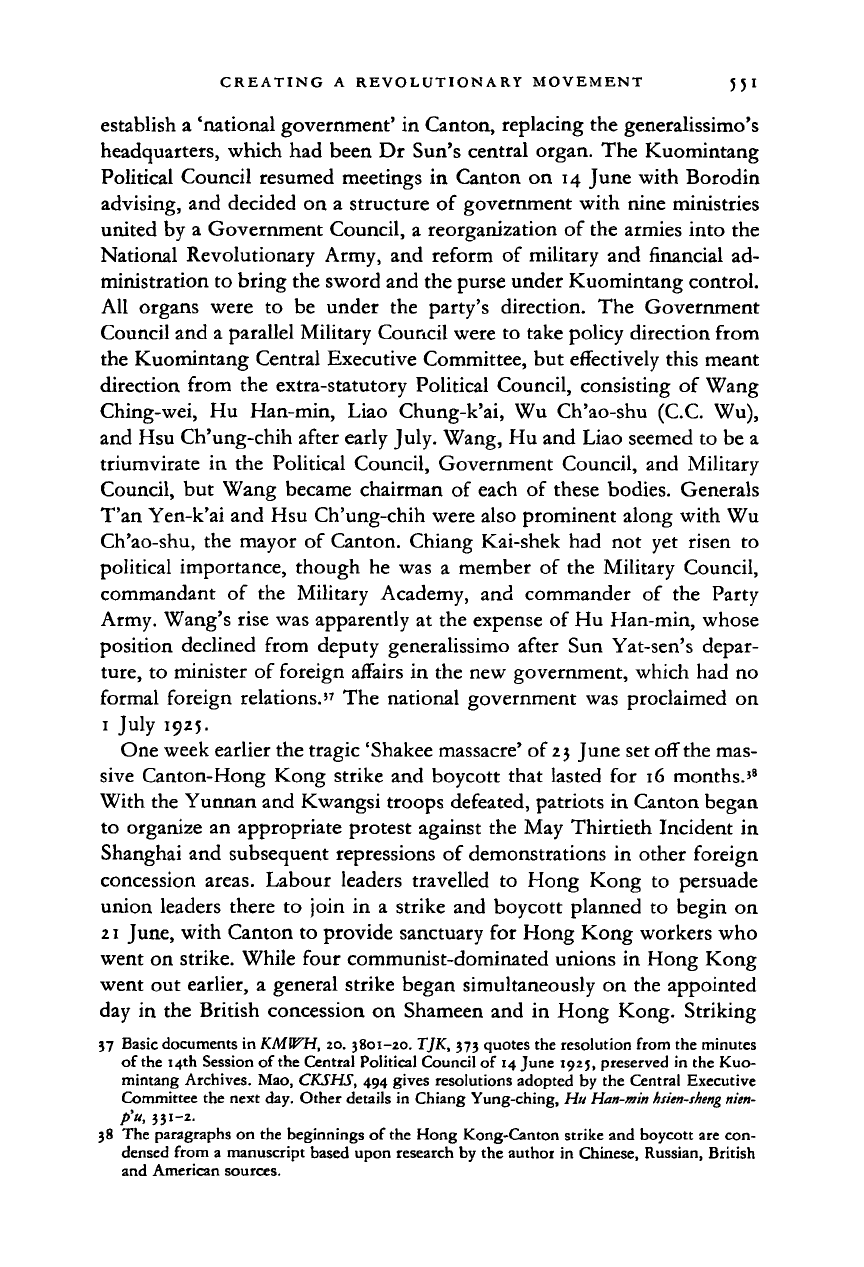
CREATING
A
REVOLUTIONARY MOVEMENT
5 5
I
establish
a
'national government'
in
Canton, replacing
the
generalissimo's
headquarters, which
had
been
Dr
Sun's central organ.
The
Kuomintang
Political Council resumed meetings
in
Canton
on 14
June with Borodin
advising,
and
decided
on a
structure
of
government with nine ministries
united
by a
Government Council,
a
reorganization
of the
armies into
the
National Revolutionary Army,
and
reform
of
military
and
financial
ad-
ministration
to
bring
the
sword
and the
purse under Kuomintang control.
All organs were
to be
under
the
party's direction.
The
Government
Council
and a
parallel Military Council were
to
take policy direction from
the Kuomintang Central Executive Committee,
but
effectively this meant
direction from
the
extra-statutory Political Council, consisting
of
Wang
Ching-wei,
Hu
Han-min, Liao Chung-k'ai,
Wu
Ch'ao-shu
(C.C. Wu),
and
Hsu
Ch'ung-chih after early July. Wang,
Hu and
Liao seemed
to be a
triumvirate
in the
Political Council, Government Council,
and
Military
Council,
but
Wang became chairman
of
each
of
these bodies. Generals
T'an Yen-k'ai
and Hsu
Ch'ung-chih were also prominent along with
Wu
Ch'ao-shu,
the
mayor
of
Canton. Chiang Kai-shek
had not yet
risen
to
political importance, though
he was a
member
of the
Military Council,
commandant
of the
Military Academy,
and
commander
of the
Party
Army. Wang's rise
was
apparently
at the
expense
of Hu
Han-min, whose
position declined from deputy generalissimo after
Sun
Yat-sen's depar-
ture,
to
minister
of
foreign affairs
in the new
government, which
had no
formal foreign relations."
The
national government
was
proclaimed
on
1 July
1925.
One week earlier
the
tragic 'Shakee massacre'
of
23
June
set
off the
mas-
sive Canton-Hong Kong strike
and
boycott that lasted
for 16
months.'
8
With
the
Yunnan
and
Kwangsi troops defeated, patriots
in
Canton began
to organize
an
appropriate protest against
the May
Thirtieth Incident
in
Shanghai
and
subsequent repressions
of
demonstrations
in
other foreign
concession areas. Labour leaders travelled
to
Hong Kong
to
persuade
union leaders there
to
join
in a
strike
and
boycott planned
to
begin
on
21 June, with Canton
to
provide sanctuary
for
Hong Kong workers
who
went
on
strike. While four communist-dominated unions
in
Hong Kong
went
out
earlier,
a
general strike began simultaneously
on the
appointed
day
in the
British concession
on
Shameen
and in
Hong Kong. Striking
37 Basic documents in
KMWH,
20. 3801-20. TJK, 373 quotes the resolution from the minutes
of the 14th Session of the Central Political Council of 14 June 1925, preserved in the Kuo-
mintang Archives. Mao, CKSHS, 494 gives resolutions adopted by the Central Executive
Committee the next day. Other details in Chiang Yung-ching, Hu
Han-min hsien-sheng
nien-
p'u,
331-2.
38 The paragraphs on the beginnings of the Hong Kong-Canton strike and boycott are con-
densed from a manuscript based upon research by the author in Chinese, Russian, British
and American sources.
Cambridge Histories Online © Cambridge University Press, 2008
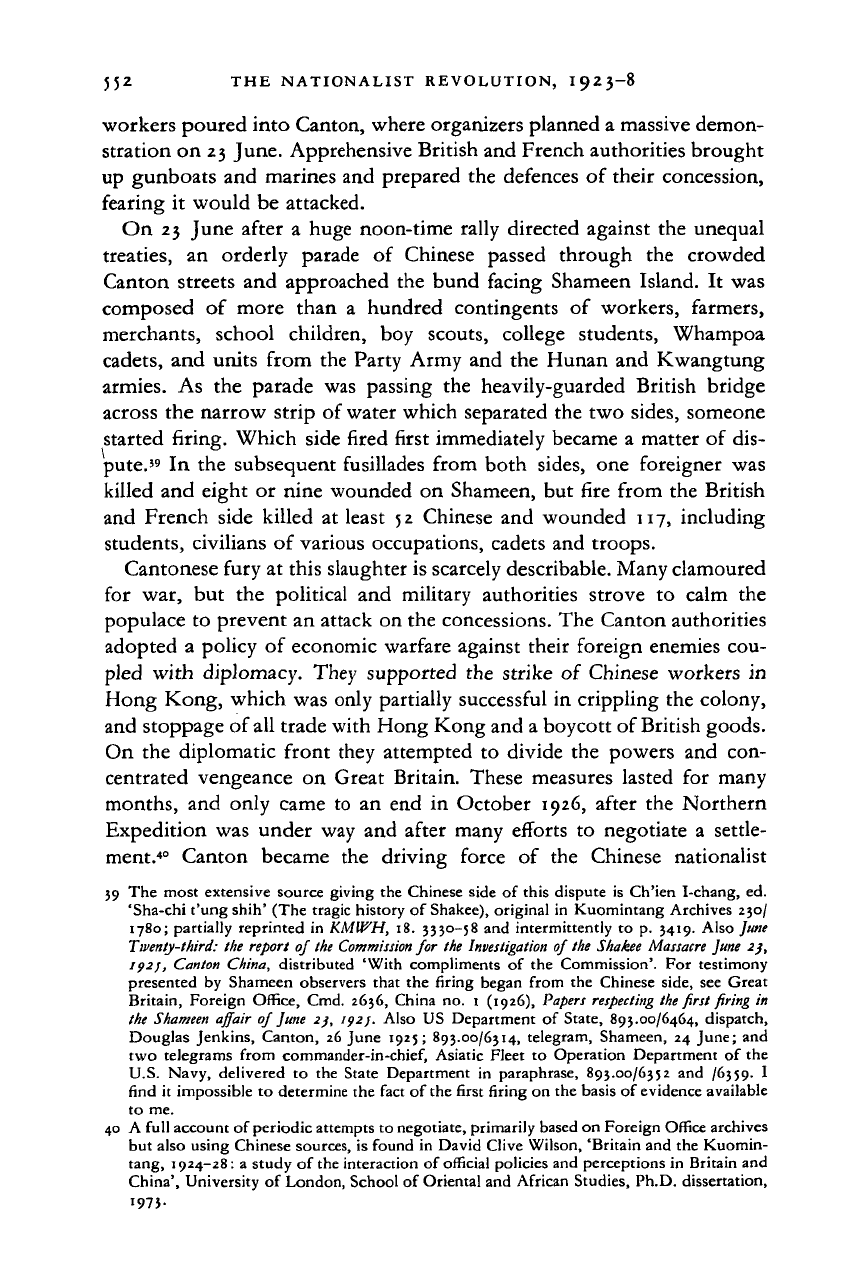
552.
THE
NATIONALIST REVOLUTION, I923-8
workers poured into Canton, where organizers planned
a
massive demon-
stration
on
23 June. Apprehensive British
and
French authorities brought
up gunboats
and
marines
and
prepared
the
defences
of
their concession,
fearing
it
would
be
attacked.
On
23
June after
a
huge noon-time rally directed against
the
unequal
treaties,
an
orderly parade
of
Chinese passed through
the
crowded
Canton streets
and
approached
the
bund facing Shameen Island.
It was
composed
of
more than
a
hundred contingents
of
workers, farmers,
merchants, school children,
boy
scouts, college students, Whampoa
cadets,
and
units from
the
Party Army
and the
Hunan
and
Kwangtung
armies.
As the
parade
was
passing
the
heavily-guarded British bridge
across
the
narrow strip
of
water which separated
the two
sides, someone
started firing. Which side fired first immediately became
a
matter
of dis-
pute.'
9
In the
subsequent fusillades from both sides,
one
foreigner
was
killed
and
eight
or
nine wounded
on
Shameen,
but
fire from
the
British
and French side killed
at
least
5 2
Chinese
and
wounded
117,
including
students, civilians
of
various occupations, cadets
and
troops.
Cantonese fury
at
this slaughter
is
scarcely describable. Many clamoured
for
war, but the
political
and
military authorities strove
to
calm
the
populace
to
prevent
an
attack
on the
concessions.
The
Canton authorities
adopted
a
policy
of
economic warfare against their foreign enemies
cou-
pled with diplomacy. They supported
the
strike
of
Chinese workers
in
Hong Kong, which
was
only partially successful
in
crippling
the
colony,
and stoppage
of
all
trade with Hong Kong and
a
boycott
of
British goods.
On
the
diplomatic front they attempted
to
divide
the
powers
and con-
centrated vengeance
on
Great Britain. These measures lasted
for
many
months,
and
only came
to an end in
October
1926,
after
the
Northern
Expedition
was
under
way and
after many efforts
to
negotiate
a
settle-
ment.
40
Canton became
the
driving force
of the
Chinese nationalist
39
The
most extensive source giving
the
Chinese side
of
this dispute
is
Ch'ien I-chang,
ed.
'Sha-chi t'ung shih'
(The
tragic history
of
Shakee), original
in
Kuomintang Archives
230/
1780;
partially reprinted
in
KMIVH,
18.
3330-58
and
intermittently
to p. 3419.
Also June
Twenty-third:
the
report
of
the
Commission
for the
Investigation
of
the Shakee
Massacre
June
2),
192;,
Canton China, distributed 'With compliments of the Commission'. For testimony
presented by Shameen observers that the firing began from the Chinese side, see Great
Britain, Foreign Office, Cmd. 2636, China no. i (1926),
Papers respecting
the first firing in
the
Shameen
affair of
June
2), 192
j.
Also US Department of State, 893.00/6464, dispatch,
Douglas Jenkins, Canton, 26 June 1925; 893.00/6314, telegram, Shameen, 24 June; and
two telegrams from commander-in-chief, Asiatic Fleet to Operation Department of the
U.S.
Navy, delivered to the State Department in paraphrase, 893.00/6352 and /6j59. I
find it impossible to determine the fact of the first firing on the basis of evidence available
to me.
40 A full account of periodic attempts to negotiate, primarily based on Foreign Office archives
but also using Chinese sources, is found in David Clive Wilson, 'Britain and the Kuomin-
tang, 1924-28: a study of the interaction of official policies and perceptions in Britain and
China', University of London, School of Oriental and African Studies, Ph.D. dissertation,
1973-
Cambridge Histories Online © Cambridge University Press, 2008
